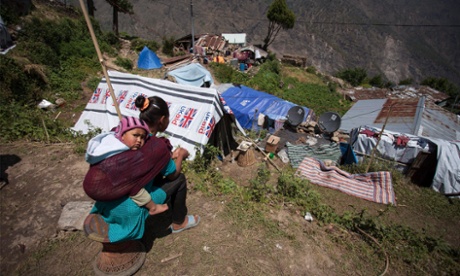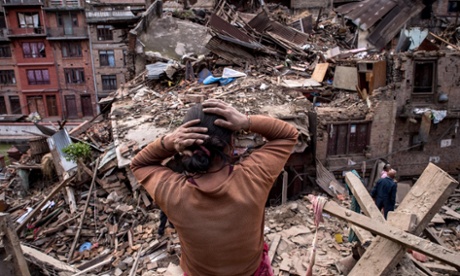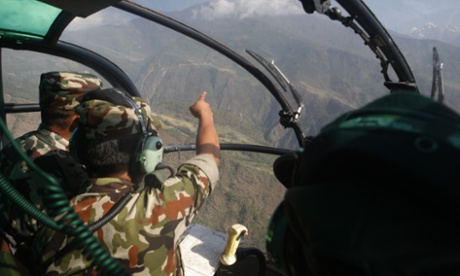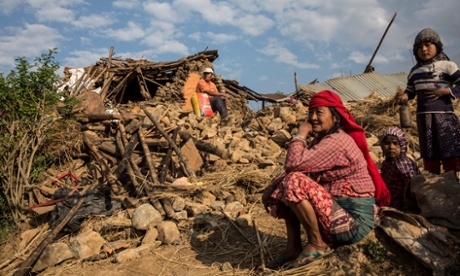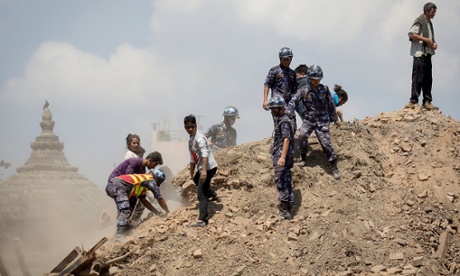A week after Nepal’s first earthquake, Yanglakot was a village on the edge of despair. Perched high on a mountain and cut off by landslides, two-thirds of its houses were destroyed, the rest uninhabitable.
When I visited, making my way there on motorbike and then on foot, women with broken legs were sitting waiting for medical help to arrive, 1,500 people were sleeping outside under a handful of tarpaulins, and food stocks were set to run out in a matter of hours.
Since the second major quake on Tuesday, despair has turned into something more like terror. Rabi Lama, 33, said that at first it didn’t feel like an earthquake. “There was this very strong noise that got louder and louder, like a machine gun, and then was a huge bang and a massive landslide fell down the other side of the valley.
“The pillars of the houses that were remaining lifted off the ground and then landed back down and then they all collapsed.”
Two people died, he said, and 35 were injured. One reason the death toll was not higher was the presence of a British trainee GP, Elena Hazelgrove-Planel, 30, from Bristol. She treated four people who were severely wounded and managed to get a helicopter rescue “in a matter of hours, which was something of a miracle,” she said, explaining that the Nepalese army had happened to be close by.
“The real tragedy is that the people that need help the most are least able to get it,” Hazelgrove-Planel said. “The worst-damaged places don’t have electricity and they can’t charge their phones or call for help, so God only knows what’s happened there.”
I ask Rabi about the father of Krishna Tamang, a 16-year-old who had shown me the remains of what was once his house. Krishna had pointed out his disabled father sitting in the rubble sorting stones and then burst into tears. Had the father survived? “The house collapsed on him,” Rabi said. “But he was lucky. We pulled him out.”
But people no longer want to stay in the village, which is in Sindhupalchok, one of the two worst affected districts, around 20 miles from the epicentre. “They don’t feel safe. They’re terrified there will be another landslide. And anyway, there’s nothing to stay for now. Do you know where there is a safe place for them to go? Can you find out?”
A couple of dozen miles away in Sanghachowk Bhanjang, on a good tarmaced road between two towns, the situation is equally bleak and the questions equally impossible to answer. The village occupies a stunning ridgetop position overlooking the sort of green folded hills that, if you squint your eyes, could be Tuscany.
Rama Giri, 31, tells me that the youngest of her three children, a boy of seven, is in hospital with head and leg injuries, and insists I look at her collapsed house. Afterwards, she asks the photographer where she lives. When she hears the answer, London, she asks: “Will you take my children with you?” There is nothing left for them here.
A neighbour, Bom Bahadur Tamang, says it used to be a place where people from other villages came to set up businesses. It had a “good location and a good road and a school”, he says. In Nepalese terms, this made it almost prosperous. A day after the second quake, it looks like the Soviet army has just passed through on its way to Berlin.
Collapsed concrete buildings line both sides of the ridge. Piles of rubble and bits of furniture press into the road. Nobody here died in this quake, unlike the last one, but after a fresh landslide none of the four houses that had been left habitable remain so.
“Do you think this building is safe?” asks Harka Bhadur Giri. It’s ravaged by cracks and perched precariously on the edge of the ridge. It’s in better shape than Bom Bahadur Tamang’s. He had spent his life savings and taken out a $11,000 loan to build it, and another $1,500 had gone to pay a bond to an employment agent who had placed his only son, 22-year-old Dal Bahadur Tamang, in a job in Malaysia.
The house, partially collapsed in the first quake, is now teetering after the second, and his son has returned home with nothing. Everything he earned had gone on the bond. But Bom still has $160 a month to pay for the debt. Will you still have to pay it now? “Of course,” he says. “Or they will take my land.”
Pay it with what? He shakes his head. The only aid the village has received so far has come from overseas agencies. “Maybe people from abroad,” he says eventually.


